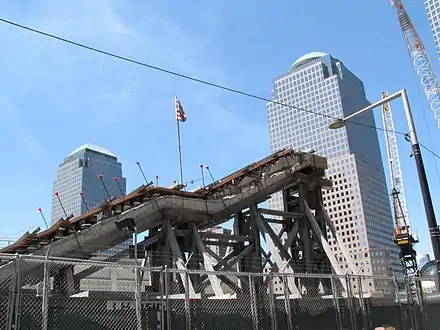Survivors' Staircase
The Survivors' Staircase was the last visible remaining original structure above ground level at the World Trade Center site. It was originally two outdoor flights of granite-clad stairs and an escalator that connected Vesey Street to the World Trade Center's Austin J. Tobin Plaza. During the September 11 attacks, the stairs served as an escape route for hundreds of evacuees from 5 World Trade Center, a 9-floor building adjacent to the 110-story towers. The staircase is now an important feature of the National September 11 Memorial & Museum.

Preservation efforts
The preservation of the staircase became a matter of dispute since May 11, 2006, when it was listed as one of America's Most Endangered Places by the National Trust for Historic Preservation.[1]
The stairs occupied part of the site of a new office building which the Port Authority of New York and New Jersey was contractually obliged to clear before the site was turned over to developer Larry Silverstein of Silverstein Properties, who in turn has a contractual obligation to develop the site as the 200 Greenwich Street office building, which is also referenced as "Tower 2" in the master plan.
The World Trade Center Survivors' Network urged the Port Authority and Silverstein to make a commitment to preserve the stairs, but neither made a public decision on the issue. Meanwhile, the already heavily damaged stairs continued to deteriorate due to the heavy vibrations caused by construction of the permanent PATH station, the World Trade Center Memorial and 1 World Trade Center on the site.
In January 2007, the Lower Manhattan Development Corporation (LMDC), according to Real Estate Weekly, rejected a plan proposed by structural engineer Robert Silman, who functioned as an independent consultant, to move the staircase in its entirety. Silman estimated the move would cost somewhere between $500,000 and $700,000 to complete. Those supporting dismantling the staircase claimed such a procedure would cost over $2 million.[2]
In early August 2007, Avi Schick, Governor Eliot Spitzer's redevelopment chief, outlined plans to remove the stairs from their concrete structure for eventual use in the World Trade Center Memorial museum. All 38 steps would be inlaid into the side of the staircase leading from the visitor's center to the underground museum.[3]
Confirming earlier plans, the LMDC announced on October 31, 2007 that the stairs would be removed and preserved, and would be restored in the future at a location inside the World Trade Center Memorial museum with a display explaining their significance.[4]
On March 9, 2008, the Staircase was moved by crane about 200 feet on Vesey Street.[5] In 2010, as construction throughout the World Trade complex reached peak activity level, the staircase – as well as two "tridents" of Twin Tower facade, and other oversize artifacts – was placed into the National September 11 Memorial & Museum space before the Memorial Plaza and museum entrance pavilion were built above it. The staircase is now a major feature of the museum.
Gallery
 2006
2006 2007
2007 2008
2008
References
- Dunlap, David W. (2006-05-11). "Ground Zero Staircase Is Put on List of Most Endangered Sites". New York Times. p. B2.
- Wolffe, Danielle (2007-01-24). "WTC staircase plan slammed". Real Estate Weekly.
- Dunlap, David W (2007-08-06). "Stairs to Remain Intact in Ground Zero Plan". New York Times.
- "Final Mitigation Plan for Adverse Effects on the Vesey Street Stair Remnant Pursuant to the World Trade Center Memorial and Redevelopment Plan Programmatic Agreement". Lower Manhattan Development Corporation (Renew New York).
- World Trade Center Staircase Moved
External links
| External media | |
|---|---|
| Images | |
| Video | |
![]() Media related to Survivors' Staircase at Wikimedia Commons
Media related to Survivors' Staircase at Wikimedia Commons